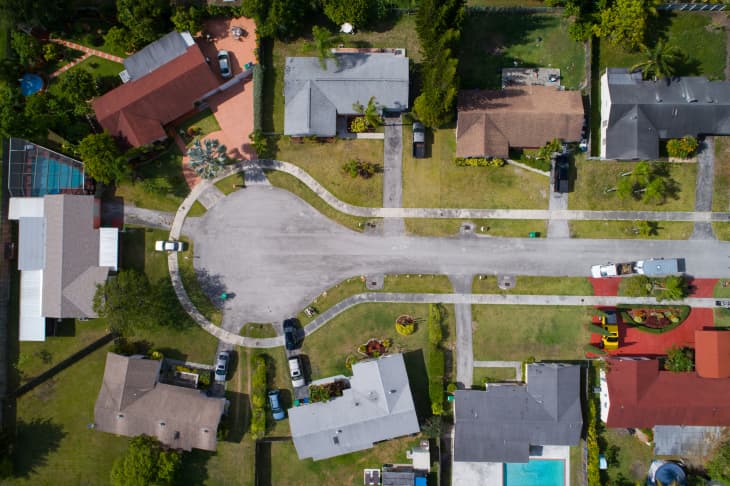The Reasons to Love Living on a Cul-de-Sac Are the Same Reasons to Hate It

Living on a cul-de-sac is the ultimate dream for some homeowners. For others, it is the bane of their existence. Let’s take a look at why this type of street that sounds so pretty in French can be so divisive.
What is a cul-de-sac?
A cul-de-sac is a private road that is closed off on one end to prevent through traffic.
Pros
- Limited road traffic
- Safe for children
- Creates close-knit neighborhood
Cons
- Not easily accessible in an emergency
- Street can turn into a noisy playground
- Neighbors might behave inconsiderately
How do you define a cul-de-sac?
For starters, here’s how to say cul-de-sac: kuhl-duh-sak.
A cul-de-sac refers to a road that is closed at one end. Unlike other streets that are perpendicular to each other and create corners, a cul-de-sac is accented by a semicircular road at its closed end. It can make for a beautiful residential neighborhood, even though the literal translation of the phrase means “bottom of the sack.”
A cul-de-sac is similar to a dead-end street, but the aesthetic is much nicer. To exit from a dead end, you’ll likely have to back awkwardly down the street or use some random person’s driveway to do a three-point turn like you learned in driver’s ed. On a cul-de-sac, however, your exit is more refined. No awkward turns necessary, just slowly drive around that semicircular road at the end and voilà! You are back where you started.
A Brief History of Culs-de-Sac
Literal translation aside, the French cul-de-sac is synonymous with the phrase “dead end” or “no exit.” It has been used to describe dead-end streets in France since the 14th century, and the British have used it in the same way since the 19th century. In America, the term has been reserved for streets with a round or bulbous end to them rather than a complete cutoff; in Australia and Canada, these types of roads are often known as courts.
Fans of “The Hobbit” and “The Lord of the Rings” might be pleased to know that J. R. R. Tolkien named Bilbo and Frodo’s underground house Bag End as a derivative of cul-de-sac — and a cheeky reference to the British adopting French phrases.
The Advantages and Disadvantages of a Cul-de-Sac
What some may view as a cul-de-sac’s biggest advantages can turn out to be the biggest drawbacks for others. Here are some things to know about life in this unique kind of neighborhood.
There’s limited road traffic.
There are only three reasons to drive down a cul-de-sac: 1) You live there. 2) You are visiting someone who lives there. 3) You are lost. In short, there’s not much traffic on a cul-de-sac, which is one of the major reasons people like living on one. This can also lead to a feeling of safety and security, in that any unusual activity on a cul-de-sac would likely raise a red flag quickly.
The drawback: There’s a dark side to not being a through road, and that has to do with it being easily accessible in an emergency. Main roads get plowed quickly in the wintertime. Culs-de-sac? Not so much. And when you do, you might be the poor homeowner at the end of the road who gets plowed in.
It’s safe for children.
Another bonus of living on a less-traversed street is that it makes it safe for families with children. Street hockey, basketball, and kickball, or just about any other game neighborhood kids play in the street can be virtually uninterrupted by road traffic.
The drawback: Not everyone loves it when their street turns into a playground. Sometimes children are left unattended, causing skirmishes among the children — and then among the parents.
It builds community.
Unlike on more linear blocks where you might only get to know your immediate neighbors, everyone is your immediate neighbor on a cul-de-sac. If you’re feeling neighborly, you might like the communal feel inherent to a cul-de-sac.
One homeowner I spoke to misses her old house, which was on a cul-de-sac. “Honestly, I can’t think of any cons to living on a cul-de-sac unless you really hate your neighbors,” she says.
The drawback: Well, you might really hate your neighbors. They might be loud. They might be inconsiderate in where they park. They might post political signs that offend you to your very core.
Whatever it is you dislike about them, they’re in your face, all the time.
If you’re thinking of moving to a cul-de-sac, some good advice would be to get a snow plow, be a good neighbor, and make sure your kids (human or animal) can play nicely with others. It will make the difference between feeling like you’re at the top of the heap or the bottom of the sack.